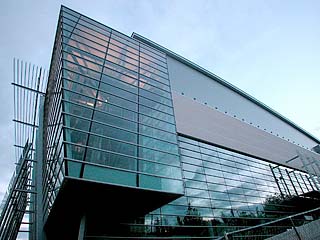|
Subscribe / Renew |
|
|
Contact Us |
|
| ► Subscribe to our Free Weekly Newsletter | |
| home | Welcome, sign in or click here to subscribe. | login |
Construction
| |
 |
November 12, 2004
Tacoma builds a not-so-conventional trade center
MulvannyG2 Architecture

Caloger
|

Zhang
|
It was the year 2000 and Tacoma's marketing team was heavy into its campaign to spread the word about the city's revitalization.
Its new tagline, "America's No. 1 Wired City," was more than just an ad campaign — it was Tacoma's stake in the ground and a signal of its burgeoning renaissance.
Wrap that enthusiasm and those high expectations into an RFP and you begin to get a sense of what the community expected for its new convention center.
Lay of the land
The site, located off Interstate 705, is situated on the corner of South 15th and Commerce streets, and surrounded by diverse districts: the city's financial center, the University of Washington Tacoma campus, the Thea Foss Waterway, the museum district and a residential area. The Link light-rail line runs down Commerce and Pacific Avenue.
The site was initially referred to as "the hole in the donut," or a zone of convergence. The challenge was to link the Greater Tacoma Convention and Trade Center with the downtown commercial district and integrate it into the neighborhood.
No problem, except the site spanned three city blocks, dropped 60 feet from Market Street to Commerce and was bisected by Broadway.
All sorts of questions loomed in the minds of the City Council and the design team:
How can we design a structure that offers multiple arrival points on a steeply sloped site? What could we do about Broadway? How is the mass of the structure, elevated on a hill, going to affect the community and city skyline? How do we foster pedestrian-oriented activity? And later: Should we build a spire?
Solving design problems

Photo by Wyn Bielaska
Architects tried to reduce the mass of the convention center by incorporating a curved roof. |
One solution was simple but unconventional: Close Broadway.
The design team was initially concerned this approach might blow its scheme out of the water since it went against city policy.
Selling points included the elimination of an unfriendly "bridge" spanning the light-rail line over Commerce, and an opportunity to provide a significant terminus for Broadway, which extends all the way to the theater district to the north. Additionally, the city would save a considerable amount of money in construction costs.
The city approved.
A second challenge — how to deal with a 13-percent grade — was a bit more involved. Suggestions included:
- Stacking major functions vertically rather than horizontally.
- Providing circulation and pre-function spaces on multiple levels along the edges of the convention center, enabling direct entry from Commerce and South 15th. Connected by a series of escalators and grand staircases, these spaces would provide direct access to registration, ballrooms, meeting rooms and the main exhibit hall, and provide a dramatic experience for users as they circulate through the convention center.
- Placing the large, contiguous space required for the 50,000-square-foot exhibit hall on the uppermost level to maximize the views and structural flexibility.
- Reducing the enormous mass of the project by using a graceful curved roof form. A layering concept employed by using carefully selected materials helps the building complement the residential neighborhood to the west.
The most controversial challenge — determining whether a proposed 420-foot-tall spire was a viable option — grew from the desire to provide an iconic wayfinder for the convention center when approaching from I-5 and I-705 to the south.
Designers envisioned the spire to have an immediate connection to Tacoma's lumber heritage and new high-tech vision. The structure's silhouette echoes a tree and is forged from modern materials. It also features a view deck that would help generate tourism revenue.
The feasibility of the spire would depend on funding as well as the future expansion plans for the convention center.
A public hub
The design philosophy was to celebrate the convention center as a public hub — a center of trade and commerce as well as a place for public gathering.
The convention center puts a face to Tacoma's heritage of industry and commerce as well as its future. As such, the design respects the established history of the community while blending it with a new vision for downtown. The result is a landmark building that further signifies the rebirth of Tacoma.
With views of Mount Rainier, the Thea Foss Waterway, the cable-stay bridge, the Tacoma Dome and Commencement Bay, the design team utilized every angle and transparent material possible to capitalize on the surrounding beauty of the area and use as much natural light as possible. The openness of the spaces encourages interaction between internal activities and the surrounding neighborhood.
Interior features also incorporate reclaimed lumber from the original buildings on the site, artistically displayed from cables hanging over lobby space.
And finally, to encourage pedestrian and civic interaction, a large plaza at the corner of Pacific and South 17th Street provides a significant public gathering space and pedestrian link from the convention center to the museum district. Along South 15th, waterfalls flank the northeastern edge of the convention center, creating visual appeal for pedestrians and providing a pleasant acoustical buffer to traffic noise.
The designers respected the scale of the community, incorporated open plazas and view-oriented spaces, and utilized modern and unobtrusive building materials. The Greater Tacoma Convention and Trade Center will serve as an urban sculpture for the fabric of the community and a center of commerce for the city of Tacoma for generations to come.
Ming Zhang and Ted Caloger are partners at MulvannyG2 Architecture.
Other Stories:
- Cooperation produced results for convention center
- Sticking to schedule, bound to the budget
- $84M project's goal: bring in out-of-towners
- Plantings, pavers tie center to the street


